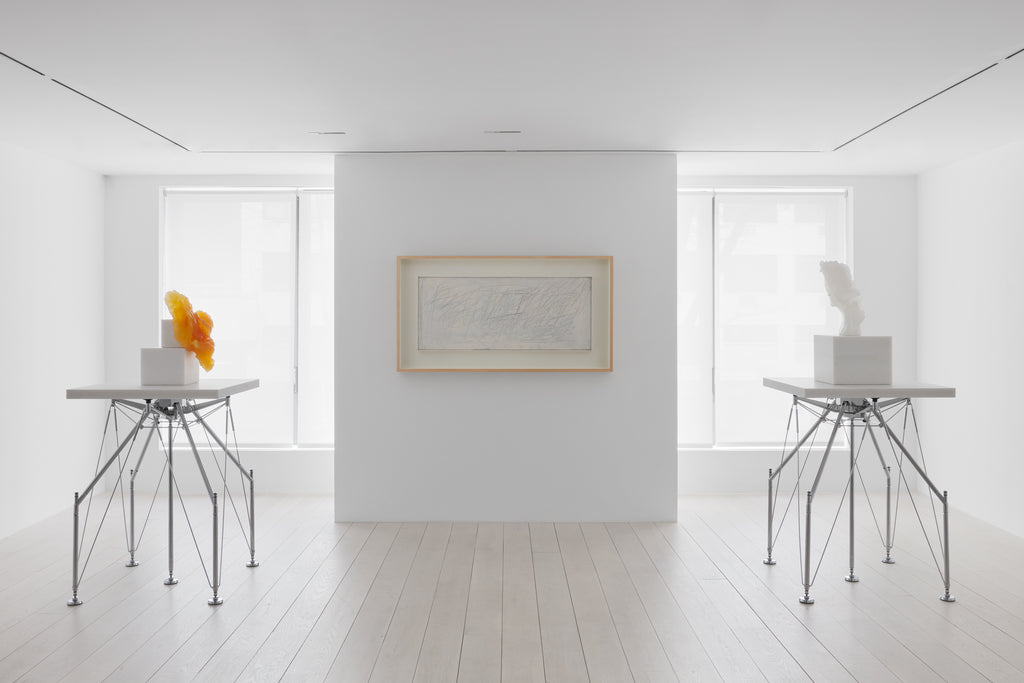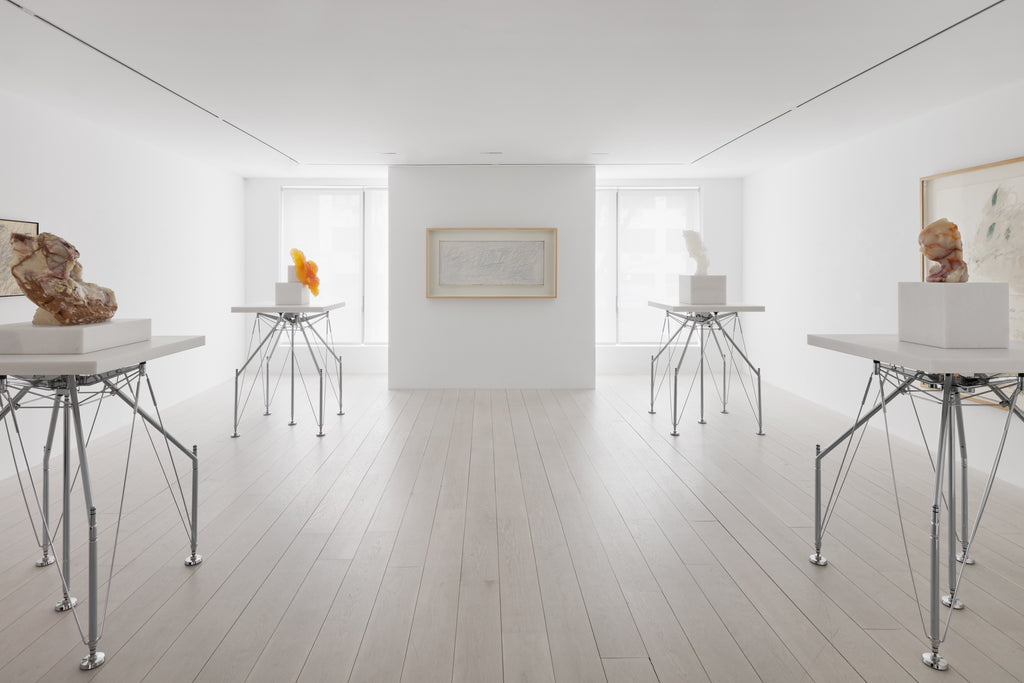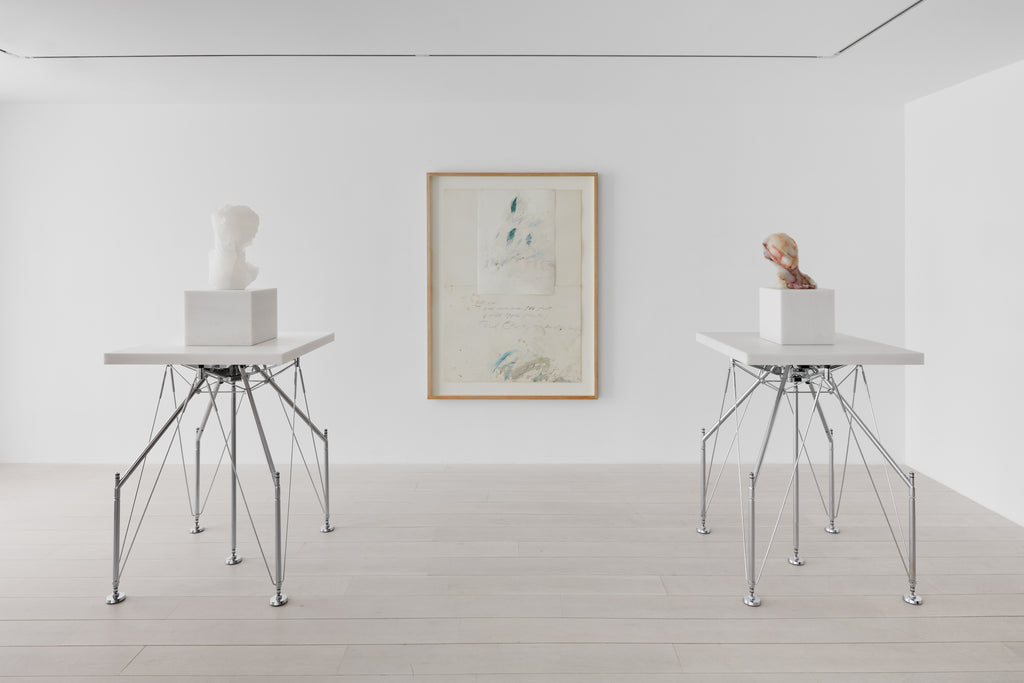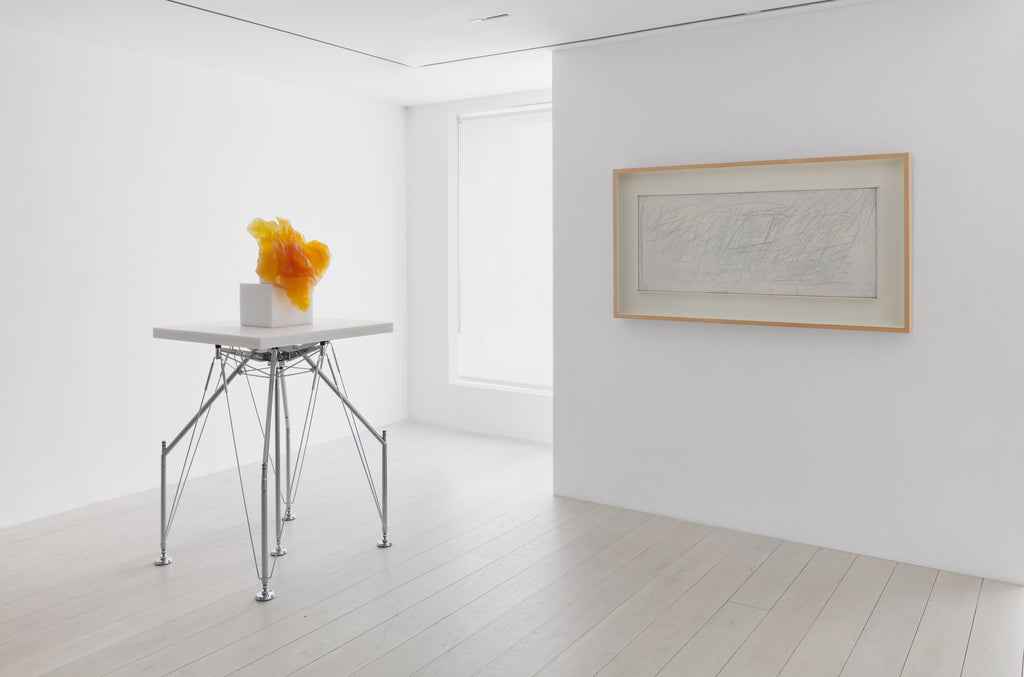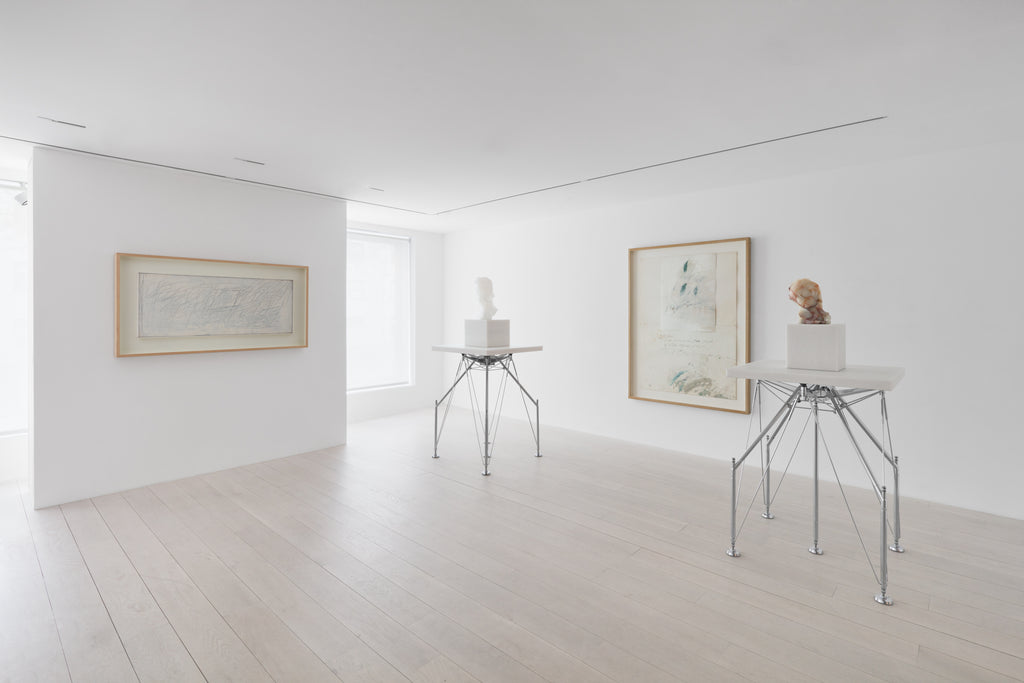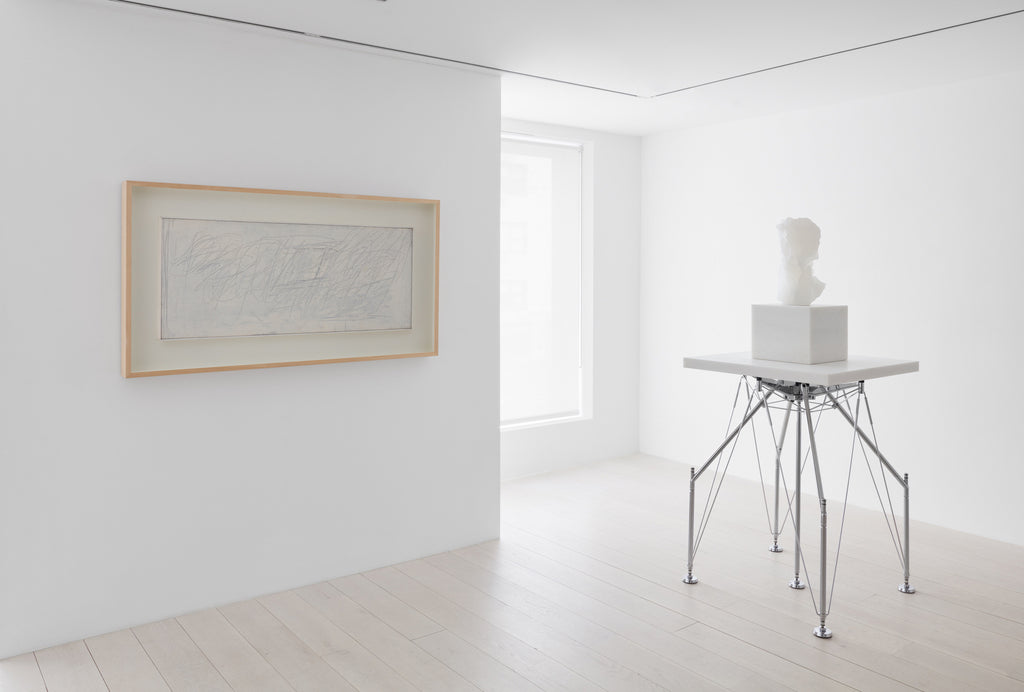Cy Twombly and Barry X Ball: A History of Painting and Sculpture at Mignoni Gallery New York in collaboration with McCabe Fine Art
Mignoni Gallery, 960 Madison Avenue, Second Floor, New York, NY 10021.
Opening hours: 31 March - 25 June, 2022. Tuesday-Friday, 10AM-6PM. Saturday, 10AM-5PM. Monday by appointment only.
Please click here to download the checklist of the exhibition.
PRESS RELEASE:
My goal from the beginning of this project has been to utilize this objective, scientific scan data trove as a starting point to create poetic new sculptures -sculptures that will retain all the power and mystery of Medardo Rosso’s while introducing a panoply of subtle alterations that will profoundly transform them and make them decidedly my works - Barry X Ball originals. Barry X Ball
NEW YORK, NY – Mignoni is pleased to present Cy Twombly | Barry X Ball: A History of Painting and Sculpture. In collaboration with McCABE FINE ART, this exhibition explores how both American artists' works were heavily influenced by their lifelong inspiration with the rich cultural heritage and history of Italy. The exhibition will include 4 paintings and works on paper by Cy Twombly alongside sculptures executed in different exotic translucent stones by Barry X Ball.
The exhibition brings together these two American Artists, who have vastly differentiating approaches to their work, yet also share an overlapping and shared influence from Italian masterpieces. Much of the inspiration pulled from their work can be pinpointed to Classical, Renaissance, and Baroque periods but also influences from artworks in the early Twentieth Century.
The work on view presents key examples of these artists' unique approaches to painting and sculpture with the shared goal of reimagining the work of masters into new poetic artworks. Twombly’s approach is to use painterly and poetic gestural movements to represent historic moments. While Barry X Ball utilizes state-of-the-art technology to refine and “perfect” sculptures into his version based on masterworks; most notably in his Medardo Rosso Project, which showcased the dialogue between two artists from different cultures, time periods and traditions.
About the Artists:
American painter, sculptor, and photographer, Edwin Parker ‘Cy’ Twombly Jr. is known for his large-scale, gestural, and abstract works. Often hailed as one of the most important artists of the post-war era, Twombly forged a distinct artistic idiom, infusing his painterly language with sources from antiquity, art history, classicism, and literature.
Born in Lexington, Virginia in 1928, Twombly – nicknamed Cy after the great baseball player Cy Young – began practicing art at a young age, taking private lessons from the age of 12. Studying in a range of schools, including the School of the Museum of Fine Arts Boston and Washington and Lee University, Twombly attended The Art Students League in New York from 1950 to 1951. It was here that he met fellow artist Robert Rauschenberg, who suggested that Twombly attend Black Mountain College in North Carolina. Here his peers included Franz Kline, Robert Motherwell, and John Cage. After his first exhibition at Samuel M. Kootz in 1951, which showed gestural, linear works inspired by Kline, Twombly received a grant which allowed him to travel to North Africa, Spain, Italy, and France. On his return to the United States in 1954, he served in the army as a cryptographer, before teaching in Virginia, and painting in his spare time. Three years later, he returned to Italy, settling in Rome where he would remain for the rest of his life. The Mediterranean landscape, history, and culture would remain central to Twombly’s painting throughout his career.
Barry X Ball born in 1955, Pasadena, CA is a contemporary sculptor based in New York. His work has been widely shown internationally over the last 35 years and is represented in many public and private collections.
A major survey exhibition of Ball’s figurative stone sculptures was staged at the Nasher Sculpture Center in Dallas in 2020. The artist’s Medardo Rosso Project debuted at Ca’ Pesaro International Gallery of Modern Art (Venice) during the 2019 Venice Biennale. A retrospective exhibition of Ball’s work was presented at the Villa Panza in Varese, Italy in 2018. Ball’s monumental Pietà and Pseudogroup of Giuseppe Panza were shown concurrently at the Castello Sforzesco Museum of Ancient Art in Milano.
Ball’s sculptures, although paying reverent homage to their historical antecedents, are completely new. Through the use of unconventional materials and innovative methods, the artist has reinvigorated the age-old tradition of figurative sculpture. Ball employs an elaborate array of equipment and procedures to realize his works, ranging from the cutting edge to the traditional, from 3D digital scanning, virtual modeling, rapid prototyping, and computer-controlled milling to exquisitely-detailed hand carving and polishing. With their simultaneous fever-pitch intensity and surreal stillness, Barry X Ball’s bravura works make an expansive case for the reconsideration of contemporary sculptural practice.
Exhibition Text By Robert Brown:
For myself the past is the source (for all art is vitally contemporary). Cy Twombly.
An exercise in contrasts, the work of Cy Twombly and Barry X Ball is both very different and yet also in many ways intriguingly similar. These are features that this first-ever paring of the two artists’ work at Mignoni, March 31 - June 25, 2022 aims to bring to light.
Cy Twombly (1928 -2011) and Barry X Ball (b 1955) are both American artists whose work has been deeply rooted in and inspired by the past, especially, by the rich cultural heritage and art history of Italy. Much of their work derives, for example, not only from Classical, Renaissance and Baroque inspirations but also from the art of pioneering Italian avant-garde artists from the early Twentieth Century such as Medardo Rosso and the Italian Futurists.
Born in Lexington, Virginia, Cy Twombly first travelled to Italy in 1953 and returned to the country in 1957, marrying and settling there. The Italian landscape, its culture, history and the ever-present nature of the past (both historic and mythological) immediately became a lifelong source of inspiration for him. Barry X Ball grew up in Los Angeles and first travelled to Italy in 1984 thereafter returning to the country regularly. Ball began his artistic career as a painter, but it was ultimately sculpture that would become his main medium. Twombly was to practice painting and sculpture simultaneously throughout his career.
Formally, these two artists’ approaches could not really be more different. Twombly’s work, often abstract, is wildly impulsive, gestural, spontaneous and deeply emotional. Ball’s predominantly figure-based sculpture is precise, analytical and conceptual. Yet, given these wholly different approaches, much of Ball and Twombly’s work has been founded upon open attempts at reinvoking, re-creating and re-inventing an Italianate past through a personal engagement with some of its great masterpieces. While Twombly often invokes an Arcadian ideal through a sequence of poetic re-imaginings and even painterly re-enactions of historic moments – scratching and scrawling sensual timelines and graffiti-like fragments of poetry and broken imagery onto the time-encrusted surfaces of his pictures - Ball directly appropriates the objects themselves.
Making use of the clinical precision of today’s very latest technology, Ball, in this way, brings the past straight into the world of the present through painstakingly-crafted, state-of-the-art, 3D digitally-scanned reproductions, recreations and reinventions of some of the greatest of Italy’s sculptural masterpieces. Where Twombly often tended to reimagine the work of Leonardo da Vinci and Nicholas Poussin for instance, Ball has been allowed direct access from Italian museums to work directly from specific sculptures by Michelangelo, Antonio Corradini, Giusto le Court, Niccolò dell’Arca, Giacomo della Quercia, Gianlorenzo Bernini, Marco d’Agrate, and Antonio Canova, as well as modernist exponents like Umberto Boccioni and, in particular, the great Italian Impressionist, Medardo Rosso.
Three of Ball’s sculptures included in this exhibition, for example, are based on ethereal early masterpieces by Rosso. Baby at the Breast of 2013-2019, here executed in a radiant and translucent Golden Honeycomb calcite, derives from Rosso’s sculpture Infante al Seno of 1890 now in the Museo Medardo Rosso in Barzio, IT. Ball’s Flesh of Others of 2013-2020, rendered in translucent ‘wounded’ Mexican onyx, is a lovingly-crafted recreation of Rosso’s 1883-4 plaster portrait of a prostitute in bed, Carne Altrui, and Hand of the Artist is a translucent golden-pink onyx riff on Rosso’s Calco della mana dell’artista of 1928. Scanned digitally from the originals in 3D and then milled in specially-selected, translucent stones by Computer-Numerically-Controlled (CNC) robots, before being painstakingly polished and refined by the hands of experienced craftsmen and women, these respectfully recreated masterworks are also wholly new, ‘perfected’, reinventions: works that have ironed out earlier flaws, quirks and errors and translated Rosso’s original vision into exotic, new, translucent coloured stone. Medardo created his works additively, by building them up, molding them of wax, plaster, and clay. Ball has purposely done the opposite – subtractively realizing his sculptures, precisely hewing them from stone blocks. The transformation has reversed and bridged the classic Rodin-versus-Michelangelo (modeling-versus-carving) sculpture division. The reversal is emphasized by the fact that Ball’s sculptures are “mirror images” of the Rossos.
Ball and Twombly’s work are both somewhat archaeological therefore in their contemplation of art-historical remnants and artefacts as inalienable touchstones of history. And it is as a consequence of this that their work, so often extremely delicate, fragile and refined, (as concerned with the telling minutiae of detail), also pulses with a powerful sense of time as a fluid and continuous arena of touch and memory. In Twombly’s work, such sensitivity has tended to take the form of a loose, meandering, graphic scrawl that literally draws upon the apparent chaos of fragments, slips, and scratches on the surface of things to weave its own lyric line as if carving through the mystical white space of his paintings like a thread through time. Similarly, what Ball has referred to as a ‘sweating of the details’ in his work is also a central part of his practice. Ball’s obsession with minutiae, however, relates directly to his desire to constantly correct, refine, perfect and improve upon the very same errors, gaps, slips and smudges from the past that so often proved to be Twombly’s inspiration.
Echoing the sculptor Medardo Rosso’s own desire to constantly perfect and improve his work by perpetually having it recast in a range of different materials, Ball’s sculpture is, in essence, similarly progressive and forward-looking. Twombly’s work, however, appears to negate such a linear concept of time. Yet something of the shared delicacy and refinement of both artists creations, as well as of the stark differences between it is to be found through a close inspection of their works’ respective surfaces. Where Twombly’s surfaces, for example, revel in a layered sense of ambiguity, Ball’s sculptures are shaped by a regulated grid of mechanically-carved lines in the form of the fine-grade flutes produced by the robotic milling of the stone. These cold, mechanical signs of process, which Ball deliberately engenders and leaves visible, stand in direct contrast to the open meanderings and ambiguous spaces of Twombly’s fine, hand-crafted lines.
Despite this fundamental difference, however, both artist’s work carries within it a profound sense of the physicality of the human body. Ball’s pristine stone sculptures are almost always centered upon a strong, iconic and singular representation of the human figure and its outward physical appearance. Twombly’s intuitive graphic language, which he once described as a ‘deeply aesthetic sense of eroded or ancient surfaces of time’, explores a more sensual and physical relationship between the human body and the action and motion of creating, often resulting in more open-form and abstract imagery.
At a fundamental level therefore, the work of these two American artists occupies similar territory but is ultimately opposed. Twombly’s aesthetic is embedded in an essentially archaic sense of the past that is wholly anathema to Ball’s deus ex machina re-creations. Twombly’s immersive approach also relies upon such things as sensation, touch, intuition and feeling as a bridge through history. Ball, by contrast, makes use of the infallible mechanised precision of lasers and robots to cut out a clear divide between one age and another, recreating ‘perfect’ or even, he argues, ‘improved’ versions and, as in the case of his spectacular Purity (after Antonio Corradini’s La Purità of 1720 – 1725), defamiliarized, mirror-images of the originals.
Masterful human images resurrected from the past and reincarnated through the awe-inspiring and sometimes disorienting media and mechanisms of today’s technology, Ball’s work carries within it a constant sense of tension between tradition and innovation, between high technology and history. And it does so in a way that opens to question the very nature of authenticity and seriality. Twombly, by contrast, was often imaginatively seeking to relocate and immerse himself within the world and experience of a completely different era to the one in which he lived. (See, for example, his Idlion of 1976, one of a series of lyrical watercolour and graphite pictures on vellum inspired by fragments of poetry written in Sicily by the ancient Greek poet Theocritus.) Twombly’s paintings make use of what he believed were the constants of human emotion and the sensations of touch and material to chart a laic journey through the flux of time. Articulating the press of a human finger into the fluid, unpredictable and always imperfect matter of paint, the eloquent twist of a graphite line, the suggestive power of a broken form or sentence and the burden of meaning carried by a symbol, his work hints at meaning but intentionally remains ethereal and elusive. Undeniably lyrical, his paintings often take the form of palimpsests or partial forms, inaccuracies, fragments, gestures and explosions of inner feeling. Layered traces of physical action and emotional release, pictures like his two Untitled paintings of 1956 and 1961 exhibited here, are ones that generate an overwhelming sense of the perpetual flux of human existence and of the path of time as fluid and open-ended arena of activity.
In very different ways therefore, both Ball and Twombly’s work appears to transcend time. Ball’s miraculously detailed and fixed icons of the human form appear to physically transpose images born from one time into that of another, transplanting, for example, the exuberance and ambition of the age of the Baroque into the computer-generated era of today. Invoking the same, essentially fluid, nature of time as do Twombly’s paintings, Ball’s sculpture gives its expression in a wholly different, almost Futuristic way. It appears to chart the passage of the immutable human image out from the dusty, antiquated space of the past and directly into the bright, new, conceptual space of the digital age and the metaverse. ‘In an internet-linked world where almost everything from every period is available to everyone’ Ball has said, ‘my aim has been to build a new type of sculpture, redolent of its sources, but [also] very much of our time.’
About McCabe Fine Art:
Launched by art advisor and dealer Paul Frank McCabe in 1997, McCabe Fine Art is dedicated to turning clients' passion for modern and contemporary art into exquisite, comprehensive collections. With a personalized and holistic approach to collecting, McCabe helps clients set and realize long-term goals. Working with institutions and private collectors worldwide, McCabe provides discrete expert counsel on placement and acquisitions.
For more information, please contact info@mccabefineart.com.


